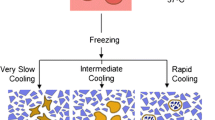Abstract
Microcarrier culture was investigated for the propagation of attenuated hepatitis A vaccine in the anchorage-dependent human fibroblast cell line, MRC-5. Cells were cultivated at 37°C for one to two weeks, while virus accumulation was performed at 32°C over 21 to 28 days. The major development focus for the microcarrier process was the difference between the cell and virus growth phases. Virus antigen yields, growth kinetics, and cell layer/bead morphology were each examined and compared for both the microcarrier and stationary T-flask cultures. Overall, cell densities of 4–5×106 cells/ml at 5–10 g/l beads were readily attained and could be maintained in the absence of infection at either 37°C or 32°C. Upon virus inoculation, however, substantial cell density decreases were observed as well as 2.5 to 10-fold lower per cell and per unit surface area antigen yields as compared to stationary cultures. The advantages as well as the problems presented by the microcarrier approach will be discussed.
Similar content being viewed by others
References
Baijot B, Duchene M and Stephenne J (1987) Production of Aujeszky Vaccine by the Microcarrier Technology From the Ampoule to the 500 litre Fermentor. Dev Biol Stand 66: 523–530.
Bektemirov TA and Nagieva FG (1980) Culturing of Herpes Virus in a Suspension Culture on a Microcarrier. Voprosy Virusologii 5: 615–618.
Butchaiah G and Rao B (1987) Growth of BHK21 C13 Monolayer Cells on Microcarriers for Production of Foot-and-Mouth Disease Virus Vaccines. Current Sci 56 (8): 346–349.
Cherry RS and Papoutsakis ET (1986) Hydrodynamic Effects on Cells in Agitated Tissue Culture Reactors. Bioprocess Eng 1: 29–41.
Clark JM and Hirtenstein MD (1981) Optimizing Culture Conditions for the Production of Animal Cells in Microcarrier Culture. Ann N Y Acad Sci 33–46.
Crespi CL and Thilly WG (1981) Continuous Cell Propagation Using Low-Charge Microcarriers. Biotechnol Bioeng 23: 983–993.
Croughan M, Hamel J and Wang DIC (1988) Effects of Microcarrier Concentration of Animal Cell Culture. Biotechnol Bioeng 32: 975–982.
DenNomme L (ca. 1987) The Propagation of MRC-5 Cells in the Celligen. In: Growth of MRC-5 Cells on Microcarriers in a Perfusion Bioreactor. Application Reports in Mammalian Cell Culture, Vosper N (ed) New Brunswick Scientific Co., Inc.
Fiorentine D, Shahar A and Mizrahi A (1985) Production of Herpesvirus of Turkeys in Microcarrier Culturing System—A New Method for Production of Vaccine Against Marek's Disease. Dev Biol Stand 60: 421–430.
Frappa Jet al. (1979) Multiplication of Normal and Virus-Infected Diploid Cells Cultivated on Microcarriers. Dev Biol Stand 42: 153–158.
Giard Det al. (1977) Virus Production with a Newly Developed Microcarrier System. Applied and Environmental Microbiology. 34 (6): 668–672.
Griffiths B and Thorton B (1982) Use of Microcarrier Culture for the Production of Herpes Simplex Virus (Type 2) in MRC-5 Cells. J Chem Tech Biotechnol 32: 324–329.
Griffiths JB, Thorton B and McEntee I (1982) The Development and Use of Microcarrier and Glass Sphere Culture Techniques for the Production of Herpes Simplex Viruses. Dev Biol Stand 50: 103–110.
Hoffman T and Palmer S (1990) Alternative Matrices for the Growth of BHK-21 Cells and the Production of Rubella Virus, In vitro 26 (3) Pt. 2: 55A.
Kotler Met al. (1985) Ion Exchange Capacity of DEAE Microcarriers Determined the Growth Pattern of Cells in Culture. Dev Biol Stand 60: 255–261.
Larsson B and Litwin J (1987) The Growth of Polio Virus in Human Diploid Fibroblasts Grown with Cellulose Microcarriers in Suspension Cultures. Dev Biol Stand 66: 385–390.
Larsson B and Litwin J (1980) Preliminary Results on the Use of Human Diploid Fibroblasts for Inactivated Polio Virus Vaccine Production. Dev Biol Stand 46: 241–247.
Meignier B (1979) Cell Culture on Beads Used for the Industrial Production of Foot-and-Mouth Disease Virus. Dev Biol Stand 42: 141–145.
Mered Bet al. (1981) Propagation of Poliovirus in Microcarrier Cultures of Three Monkey Kidney Cell Lines. J Biol Stand 9: 137–145.
Pay TWFet al. (1985) Production of Rabies Vaccine by an Industrial Scale BHK 21 Suspension Cell Culture Process. Dev Biol Stand 60: 171–174.
Provost P. Unpublished data.
Scattergood EMet al. (1983) Scale-up of Chick Cell Growth on Microcarriers in Fermenters for Vaccine Production. Ann N Y Acad Sci 413: 332–339.
Spier RE and Whiteside JP (1976) The Production of Foot and Mouth Disease Virus from BHK 21 C13 Cells Grown on the Surface of DEAE Sephadex A50 Beads. Biotechnol Bioeng 28: 659–667.
Van Hemert P, Kilburn DG and van Wezel AL (1969) Homogeneous Cultivation of Animal Cells for the Production of Virus and Virus Products. Biotechnol Bioeng 11: 875–885.
Van Wezel AL and van Steenis G (1978) Production of an Inactivated Rabies Vaccine in Primary Dog Kidney Cells. Dev Biol Stand 40: 69–75.
Varani Jet al. (1985) Substrate-dependent Differences in Growth and Biological Properties of Fibroblasts and Epithelial Cells Grown in Microcarrier Culture. J Biolog Standardization 13: 67–76.
Varani Jet al. (1986) Proteolytic Enzymes and Arachidonic Acid Metabolites Produced by MRC-5 Cells on Various Microcarrier Substrates. In Vitro Cell Dev Biol 22 (10): 575–582.
Varani Jet al. (1989) Substate-Dependent Differences in Production of Extracellular Matrix Molecules by Squamous Carcinoma and Diploid Fibroblasts. Biotechnol Bioeng 33: 1235–1241.
von Seefried Aet al. (1984) Inactivated Poliovirus Vaccine and Test Development at Connaught Laboratories Ltd. Reviews of Infectious Diseases 6 (2): S345-S349.
Widell A, Hansson BG and Nordenfelt E (1984) A Microcarrier Cell Culture System for Large Scale Production of Hepatitis A Virus. J Virolog Meth 8: 63–71.
Author information
Authors and Affiliations
Rights and permissions
About this article
Cite this article
Junker, B.H., Wu, F., Wang, S. et al. Evaluation of a microcarrier process for large-scale cultivation of attenuated hepatitis A. Cytotechnology 9, 173–187 (1992). https://doi.org/10.1007/BF02521745
Received:
Accepted:
Issue Date:
DOI: https://doi.org/10.1007/BF02521745




